Military officials often utilize the PMESII-PT as an analytical tool – a starting point to assess and define defense and military environments. PMESII stands for Political, Military, Economic, Social, Information, and Infrastructure. Two additional variables – Physical environment and Time were added later to the tool.
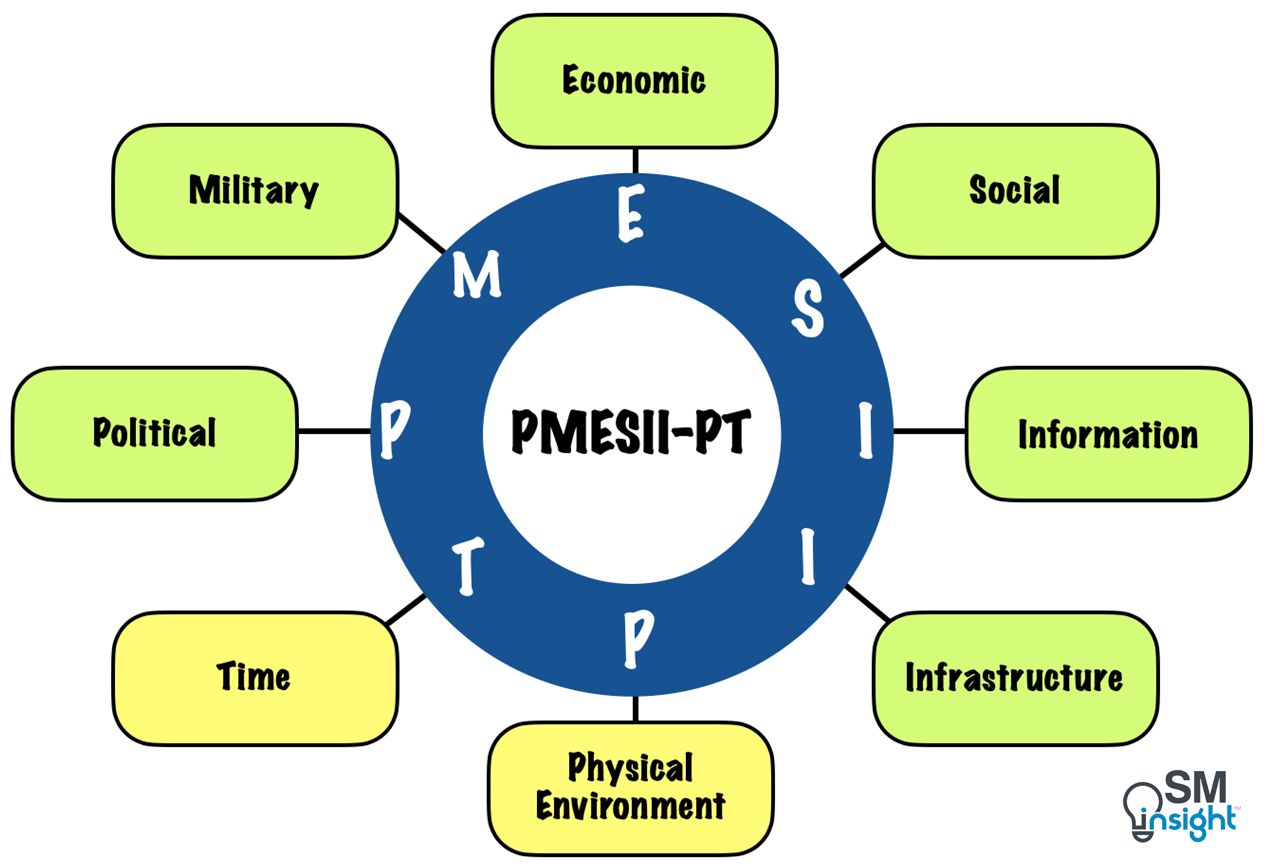
Although the original intent of PMESII-PT is not easily identifiable, it was a result of the US military efforts to come up with a way to assess the various systems at play in an operational environment (OE).
The military operates in a wide variety of OEs including areas of conflict, post-conflict or failed states, humanitarian, disaster relief, and support and reconstruction operations. Such operations require increased coordination and integration with a range of civilian domestic and international organizations – nongovernmental organizations, private voluntary organizations, and humanitarian relief organizations.
Additionally, the characteristics of conditions within an OE evolve constantly while exhibiting complexity, volatility, uncertainty, instability, and ambiguity in events that change in speed, pace, and tempo. Given these complexities, the eight operational variables of PMESII-PT help gain a holistic and detailed understanding of the OE.
PMESII-PT Uses case
The impetus for creating PMESII-PT was twofold [1]:
- First, just as the military would target systems like tanks and air assets in a conventional conflict to achieve victory, the creators of PMESII-PT wanted to target the systems involved with nation-building to achieve success.
- Second, members of the joint community were not content with ASCOPE as a tool to assess systems and wanted a more encompassing methodology. ASCOPE stands for Area, Structure, Capabilities, Organizations, People and Events.
Today the U.S. military uses ASCOPE as a bare minimum to collect and structure the information while PMESII-PT is used to further refine that information. The results are then combined and matched up in a matrix where each box contains a list of parameters for more detailed analysis.
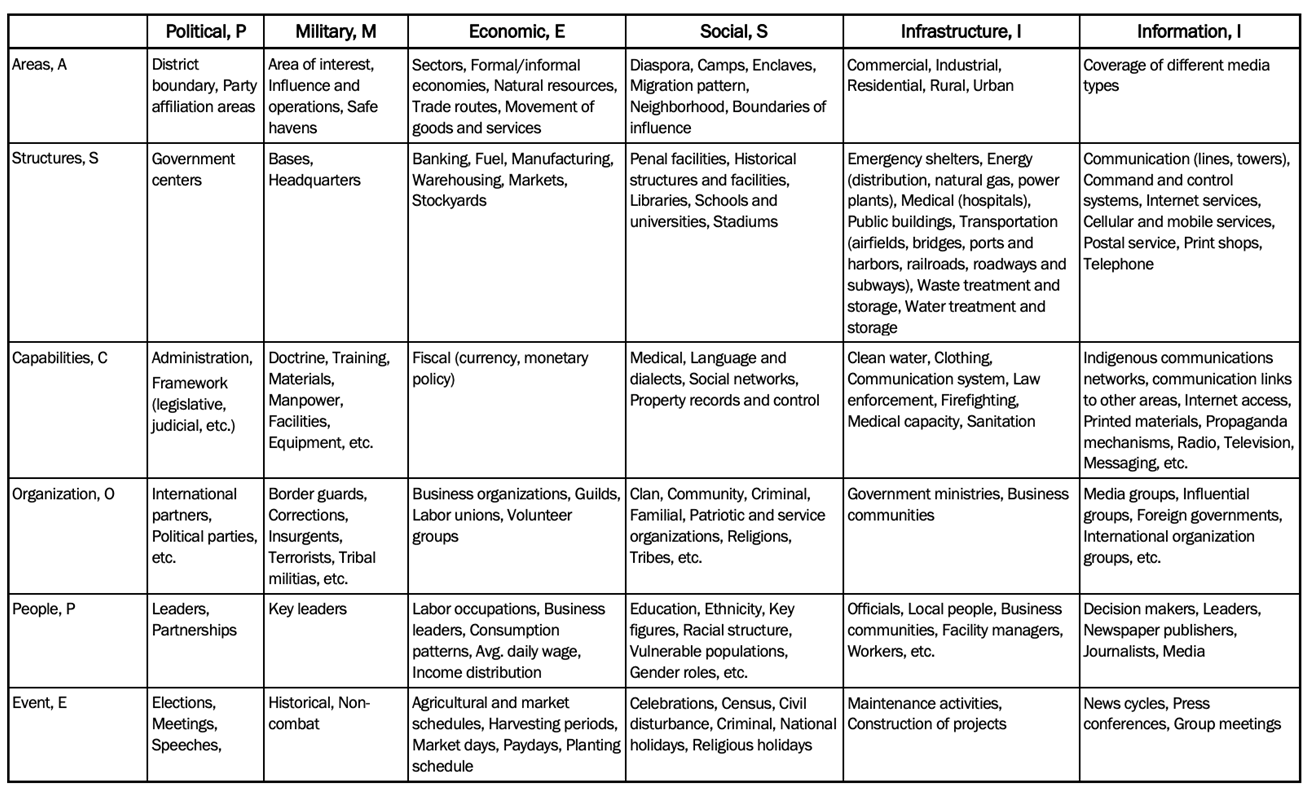
Relevance in business
Just as military environments are complex and multidimensional, business operating environments too are complex, and require a balance of regular and irregular competencies to navigate [3].
Though PMESII-PT was developed for military applications, it has found applications as a business-environment scanning and monitoring tool in performing a structured analysis of a business’s operating environment.
PMESII-PT is compared with tools such as SWOT Analysis [4], PESTLE [5] and QEST [6] which have similar applications but PMESII-PT has a much broader scope. Analyzing each of the PMESII-PT variables helps businesses gain insights into their operating environment in a structured manner.
For example, a firm that wants to expand its business to a new country can use the tool to assess the political stability, economic growth, social norms, information access, infrastructure quality, physical geography, and time its entry such that it is at an advantage.
Such an assessment helps decide whether to enter the market, how to enter the market, and what resources and capabilities to deploy.
PMESII-PT also help firms monitor and adapt to the changes and challenges in their environment. For example, a firm that operates in a volatile region can use PMESII-PT to track the political, military, and social developments that may affect operations. It can then adjust its strategies and plans or prepare for contingency scenarios.
PMESII-PT variables explained
Since PMESII-PT was designed by the US military (from the U.S. point of view), it is worded with numerous military jargon. Nevertheless, many of these concepts are relevant and can be applied to a business setting:
Political Variable
Political variable describes the distribution of responsibility and power at all levels of governance—formally constituted authorities, as well as informal political powers. This includes influential political groups and the collective attitude of the population in the OE towards the US.
A firm analyzing the Political Variable and its sub-settings must interpret/replace “U.S.” with its home country in the below definitions.
The specific Political sub-variables and their settings are as follows:
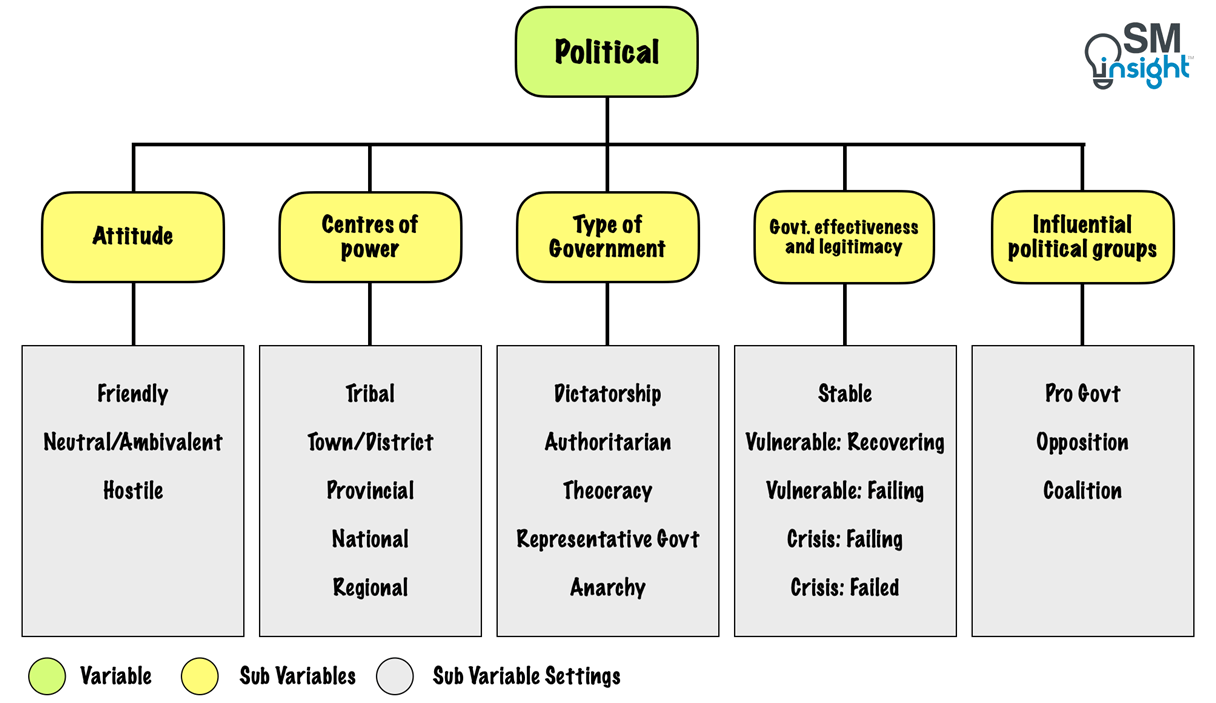
The definitions of each of the political sub-variable settings are as follows:
Attitude
Describes the attitude of the government in the OE toward the U.S. and specifically toward the presence and actions of U.S. and/or coalition forces.
Attitude consists of the following sub-variable settings:
- Friendly: Describes an overall favorable, positive reception of a country, including its coalition forces activities, presence, and initiatives.
- Neutral/Ambivalent: Describes an undecided reception of a country, including its coalition forces’ activities, presence, and initiatives.
- Hostile: Describes an unfavorable, negative reaction of a country, including its coalition forces’ activities, presence, and initiatives.
A business has a greater chance of success when the government in the OE in which it operates has a friendly to neutral attitude towards its home country/government.
Centers of Political Power:
Determines the types of bureaucratic divisions and/or centers of power within a government in the OE. Also includes the level of the governmental span of control from tribal to regional/national level. Centers of Political Power consist of the following sub-variable settings:
- Tribal: Tribal focus, limited government, or government of limited influence. Characterized by tribal elders, and religious figureheads.
- Town/District: Towns and some districts focus on the government’s day-to-day operations.
- Provincial: Provincial and minimal cross-border focus by the local and provincial government.
- National/Regional: International and cross-border focus based on the existence of multiple regions or national borders in the scenario OE.
A broader span of government control is advantageous for business operations. Too many divisions and isolated pockets of power can be challenging for operations.
Type of Government:
Determines the type of government structure and associated behaviors encountered in the OE. Type of Government consists of the following sub-variable settings:
- Dictatorship/Authoritarian: A mode of government characterized by the existence of a single ruler or group who monopolizes state power, exercising it without restraint.
- Theocracy: A government ruled by or subject to religious authority. A system of government in which God or a deity is held to be the civil ruler.
- Representative Government: A representative form of government – either democratic, republic, or parliamentary in form—with elected representatives and executives. All politics are governed by the will of the people and the government has limited, defined powers over the population.
- Anarchy: Absence of any form of political authority. Political disorder and confusion. Absence of any cohesive principle, such as a common standard or purpose.
Dictatorship/Authoritarian regimes require scrutiny for stability, whereas businesses should steer clear of regions marked by anarchy.
Government Effectiveness and Legitimacy:
Effectiveness refers to the capability of the government in the OE to work with society to ensure the provision of order and public goods and services.
Legitimacy refers to the perception by important segments of society that the government is exercising state power in ways that are reasonable, fair and in the interests of the nation.
Government effectiveness and legitimacy consist of the following sub-variable settings:
- Stable: The government is able and willing to provide adequate security and essential services to significant portions of its country’s population. It provides military and police services that secure borders and limit crime while being reasonable, equitable, and without major violation of human rights. It provides basic services that generally meet demand. Political institutions, processes, norms, and leaders are acceptable to the citizenry and ensure adequate response to citizen needs.
- Vulnerable: Recovering – The government is recovering from the crisis and is still either unable or unwilling to provide adequate security and essential services to all of the population. The legitimacy of the central government may still be in question and there is limited civil unrest.
- Vulnerable: Failing – The government is either unable or unwilling to provide adequate security and essential services to significant portions of the population. Its legitimacy is questionable and there is increasing civil unrest.
- Crisis: Failing – The central government does not exert effective control over all the country’s territory. It is unable or unwilling to provide security and essential services for significant portions of the population. There is a great risk of violent internal conflict.
- Crisis: Failed – The central government does not exert effective control over the country’s territory. It is unable to provide security and essential services for significant portions of the population. The central government is weak, nonexistent, or simply unable to provide security or basic services. Violent internal conflict is a reality.
Businesses must avoid operations in regions of vulnerability and crisis.
Influential political groups:
This sub-variable describes the number and specifies the interaction and influence of various political groups within the OE. It helps define the level of cohesion and strife within the government and consists of the following sub-variable settings:
- Pro-government: Major political parties generally support the government in power. Minimal dissent and issues of contention.
- Coalitions: Different political groups with competing interests vary in their support of the government. There is a possibility of moderate disruption of essential government functions and social volatility.
- Opposition: Different political groups are opposed to the government with competing interests. There is a threat of major disruption of essential government functions and social volatility.
Military Variable
The Military variable explores the military and/or paramilitary capabilities of all relevant actors (enemy, friendly, and neutral) in a given OE. This includes nonmilitary armed and unarmed combatants.
This variable focuses on giving the exercise planner the ability to design appropriate opposition force units for full-spectrum operations. The specific military sub-variables and their settings are as shown:
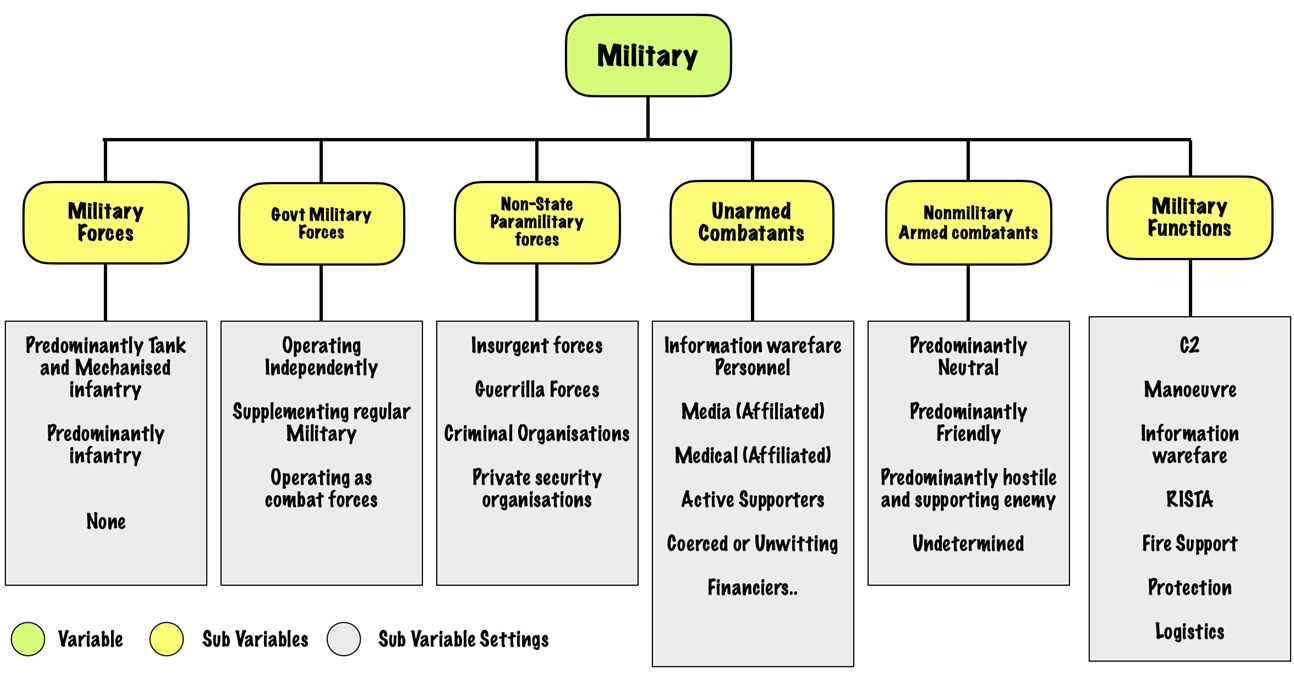
It is unlikely that a business will analyze the Military Variable and its sub-settings in great detail as they are relevant only in a military setting. Hence, this article will avoid discussing them in more detail. Definitions are available in the U.S. Department of the Army’s exercise design manual TC 7-101 Table 3.8 through 3-13 [7].
Economic Variable
The Economic variable encompasses individual and group behaviors related to producing, distributing, and consuming resources. Specific factors impacting behavior may include economic diversity and employment opportunities within an OE.
Other factors include the black market or underground economies, which are alternative structures that indicate weaknesses in the mainstream economy. Such factors influence people’s decisions to alter or support the existing order. It also alters the demand for products in the formal market.
The specific economic sub-variables and their settings represent replicable economic conditions that may be present within an OE and are as shown:
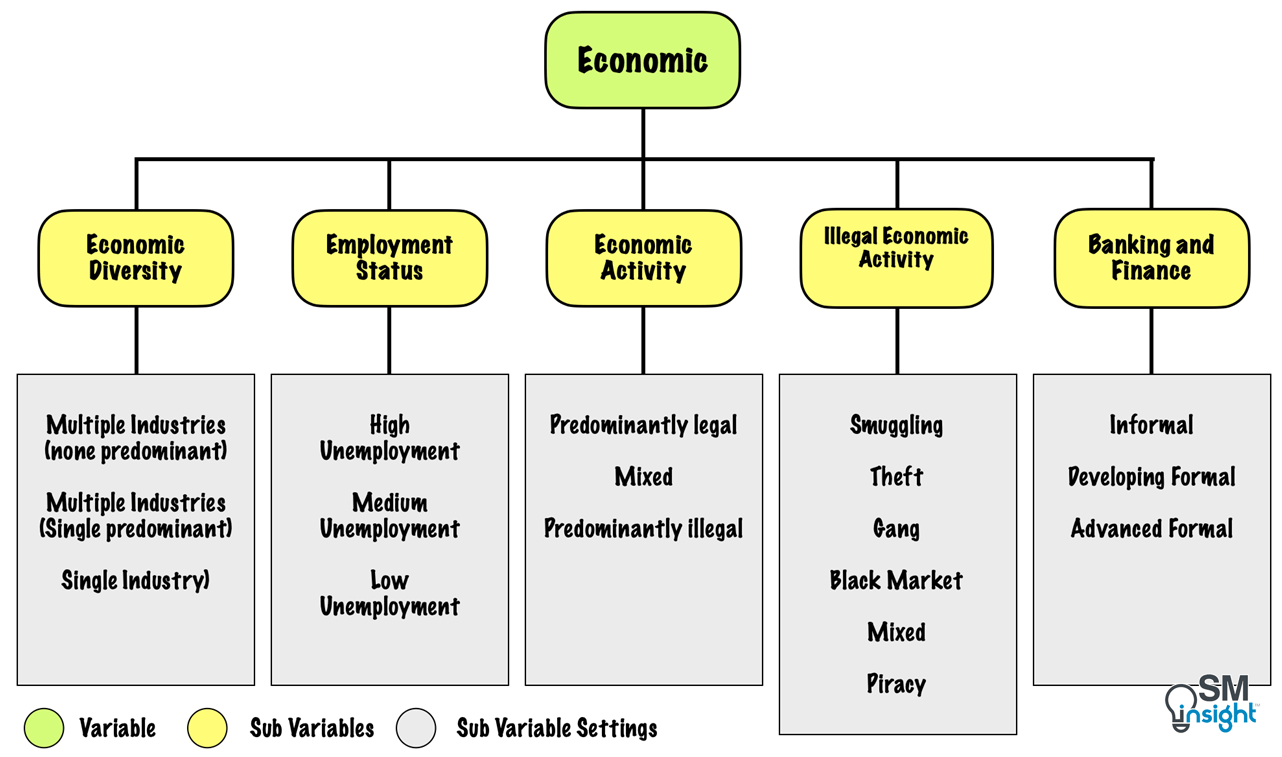
The definitions of each of the economic sub-variable settings are as follows:
Economic diversity
Describes the different economic industries and their relative mix that may exist in a given country/region. It consists of the following sub-variable settings:
- Multiple industries (none-predominant): Describes the condition where multiple industries are present in an economy with each roughly equivalent in terms of their overall contribution to the economy.
- Multiple industries (single-predominant): Describes the condition where multiple industries are present but one of them is more productive relative to the others.
- Single industry present: Describes the condition where a single industry is economically significant.
Taiwan, for example, depends heavily on chip exports which contribute to almost 25% of the country’s GDP. This makes Taiwan extremely vulnerable to several economic and political shifts, including China’s increased military exercises and chip production moving to the US [8]. A business looking to enter such an economy must consider the risks and weigh them against more “balanced” economies that could promise greater stability.
Employment status
This represents the overall employment status of the populace. The US military defines three segments based on employment status:
| High Unemployment | 2/3rd of the population is unemployed |
| Moderate Unemployment | Half the population is unemployed |
| Low Unemployment | The majority are employed |
The employment status serves as an indirect gauge of an economy’s health for a business. It should adapt these definitions to align with its context, considering factors such as skill level, education, and the predominant industry of the workforce.
Economic activity
Describes the type of economic activity present in an area of operation and consists of the following sub-variable settings:
- Predominantly Illegal: The economy lacks many products and services. Black market operations robbery, smuggling, and organized crime are widespread.
- Mixed: Legal economy mixed with some smuggling and black-market trade in controlled items.
- Predominantly Legal: Limited black market, robbery, or organized crime activities.
Illegal economic activity
Describes the predominant type of illegal economic activities present in the area of operation and consists of the following sub-variable settings:
- Smuggling: The acquisition, distribution, and sale of a controlled, restricted, or forbidden item.
- Theft/Looting: Small theft rings that acquire and distribute stolen property.
- Gang/Organized Crime: Criminal activities such as bribery, coercion, thuggery, protection racket, and inter-gang rivalry.
- Black market: The underground economy or black market is a market where all commerce is conducted without regard to taxation, law, or regulations of trade.
- Piracy: Robbery, hijacking, or other acts of violence on the high seas. Can also include acts committed in other major bodies of water or on a shore.
- Mixed/Multiple Activities: More than one of the above activities is present in the area of operation.
For obvious reasons, a business must analyze these sub-settings and avoid operating in markets with excessive illegal economic activity.
Banking and Finance
Focuses on the characteristics of the institutions responsible for acting as payment enablers to borrow and lend money. They can be classified into the following types:
- Informal: A private moneylender-type arrangement.
- Developing-Formal: Mixture of private moneylenders and banking infrastructure.
- Advanced-Formal: Banking infrastructure prevalent throughout the area of operation. Private money lending is restricted to criminal/gang activity.
Formal banking infrastructure is critical for businesses to operate and scale.
Social Variable
Social variable describes the cultural, religious, and ethnic makeup within an OE and the beliefs, values, customs, and behaviors of society members. Societies are comprised of structured and overlapping groups and institutions, each with relative statuses and roles that support, enable, and provide opportunities to achieve personal or community expectations.
Understanding these complex interrelationships in a society is vital for both, military, and business operations alike. The social sub-variables settings that may be present within an OE are depicted below:
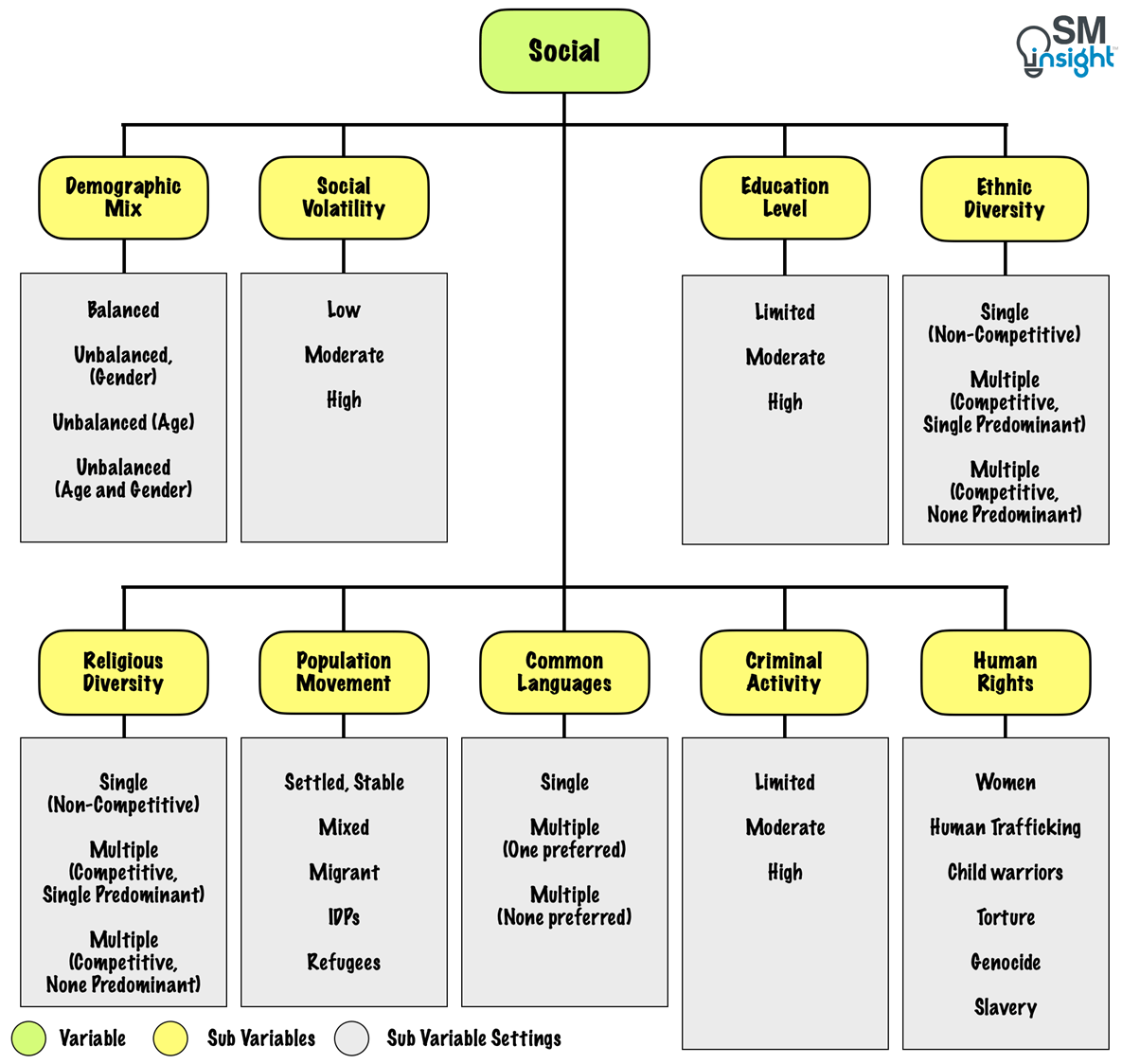
The definitions of each of the social sub-variable settings are as follows:
Demographic mix
Describes the gender and age balance of the population. In the military context, age refers to the range of age in which an individual can serve in the military. In the business context, it refers to the employment age. Demographic mix can be classified into the following:
- Balanced: A population consisting of equal proportions of gender and age.
- Unbalanced, Gender: A population consisting of an unequal proportion by gender (male, female) in relation to the overall group (for example: 65% male). The age proportion of the population is not affected and remains the same as if it were in a balanced setting.
- Unbalanced, Age: A population consisting of a greater proportion of a particular age group in relation to the overall population (for example: 60% above 50 yrs). The gender proportion of the population is not affected and remains the same as if it were in a balanced setting.
- Unbalanced, Gender and Age: A population consisting of unequal proportions of both gender and age in relation to the overall group.
Social volatility
Describes the amount of conflict between religious or ethnic groups present in a society and the amount of civil unrest present. It consists of the following sub-variable settings:
- Low: Low intergroup conflicts. Civil unrest is minimal. No significant refugee presence. High religious, ethnic, and political diversity.
- Moderate: Moderate intergroup conflicts. Civil unrest is sporadic. Minimal refugee presence. Some lack of religious, ethnic, and political diversity.
- High: High intergroup conflicts. Civil unrest is significant. Large refugee presence. Significant lack of religious, ethnic, and political diversity.
Education Level
Describes the education level of the population and consists of the following sub-variable settings:
- Limited: Limited population literacy and education. No more than 25% of the workforce is literate or educated. Primitive education infrastructure and high unemployment.
- Moderate: Moderate population literacy and education. No more than half of the workforce is literate or educated. Some education infrastructure and moderate unemployment.
- High: High population literacy and education. More than 75% of the workforce is literate or educated. Significant education infrastructure and low unemployment.
While the above classification of education level is based on the U.S. military’s definition, the same may be modified as relevant to the business context.
Ethnic diversity
Describes the number and specifies the interaction of various ethnic groups within a given population and consists of the following sub-variable settings:
- Single Group, Non-Competitive: A single ethnic group is present, there is no competition.
- Multiple Group, Competitive, Single Predominant: Up to three distinct ethnic groups distributed throughout a given area with one group identifiable as the dominant population.
- Multiple Group, Competitive, Non-Predominant: Three or more distinct ethnic groups distributed throughout a given area with no group designated as the dominant population.
Religious diversity
Describes the number and specifies the interaction of various religious groups within a state or scenario population and consists of the following sub-variable settings:
- Single Religion, Noncompetitive: Populace follows a single religion, there is no competition.
- Multiple Religions, Competitive, Single Predominant: Up to three distinct religious groups distributed within a given area with one religion dominant.
- Multiple Religions, Competitive, Non-Predominant: Three or more distinct religious groups distributed within a given area, none of them are dominant.
Understanding ethnic and religious diversity helps businesses foster greater sensitivity toward their operating environment.
Population movement
Describes the prevalence of migrant populations, internally displaced persons, and refugees within a country, region, or area and consists of the following sub-variable settings:
- Settled, Stable: Population is settled, organized, and does not move or displace except when confronted with occasions of extreme duress.
- Mixed: Part of the population is settled, and part moves frequently.
- Migrant: Population frequently moves as a part of the normal state of affairs.
- Internally Displaced Persons (IDPs): A person who is involuntarily moved inside the national boundaries of his or her country.
- Refugees: A person who, by reason of real or imagined danger, has left their home country or country of their nationality and is unwilling or unable to return.
Regions with high migrant, IDP and refugee populations may indicate instability.
Common languages
The preferred language(s) of a specific country or region or lack thereof. This can be classified into the following sub-variable settings:
- A Single preferred and predominant language.
- Multiple languages with one preferred language: several languages exist but one is recognized and used by the population as the preferred language.
- Multiple languages with no preferred or predominant language: there is no preferred or predominant language. Frequently found in failed nation-states or states where the national language is not used except in specialized areas such as commerce.
Criminal activity
Defines the level of criminal activity present in society and can be classified into Limited, Moderate and High. The US military classifies this into the following sub-variable settings:
- Limited: Up to 2 activities are present in no more than 30% of the total urban landscape which can be classified as criminal.
- Moderate: Up to 3 activities are present in no more than 50% of the total urban landscape which can be classified as criminal.
- High: 4 or more activities are present in more than 75% of the urban landscape which can be classified as criminal. Characterized by an active presence of criminal gangs or organizations.
For obvious reasons, a business must understand the level of criminal activity in its area of operations as this can affect its operations, customer base and even employees.
Human rights
Refers to the basic rights and freedoms to which all humans are entitled. This includes civil and political rights, such as the right to life and liberty, freedom of expression, and equality before the law; and economic and social rights, including the right to participate in culture, the right to food, the right to work, and the right to education.
The US military has a long list of sub-variable settings under human rights. The ones relevant in the context of a business include women’s rights, rights of children (preventing child labor), human trafficking (preventing trafficking of labor), preventing slavery etc.
For example, businesses that subcontract activities to countries with a known history of human trafficking may risk aiding the industry unknowingly / indirectly. Workers might be held against their will and deprived of the right to leave, refuse to work, or receive inadequate compensation.
For example, Lululemon, the high-end sportswear brand, was accused of sourcing clothing from a factory where Bangladeshi female factory workers claimed they were beaten and physically assaulted [9].
Information Variable
Information variable describes the nature, scope, characteristics, and effects of individuals, organizations, and systems that collect, process, disseminate, or act on information. It includes access, use, manipulation, distribution, and reliance on information technology systems.
The specific information sub-variables and their settings represent replicable conditions that may be present within an OE and are depicted below:
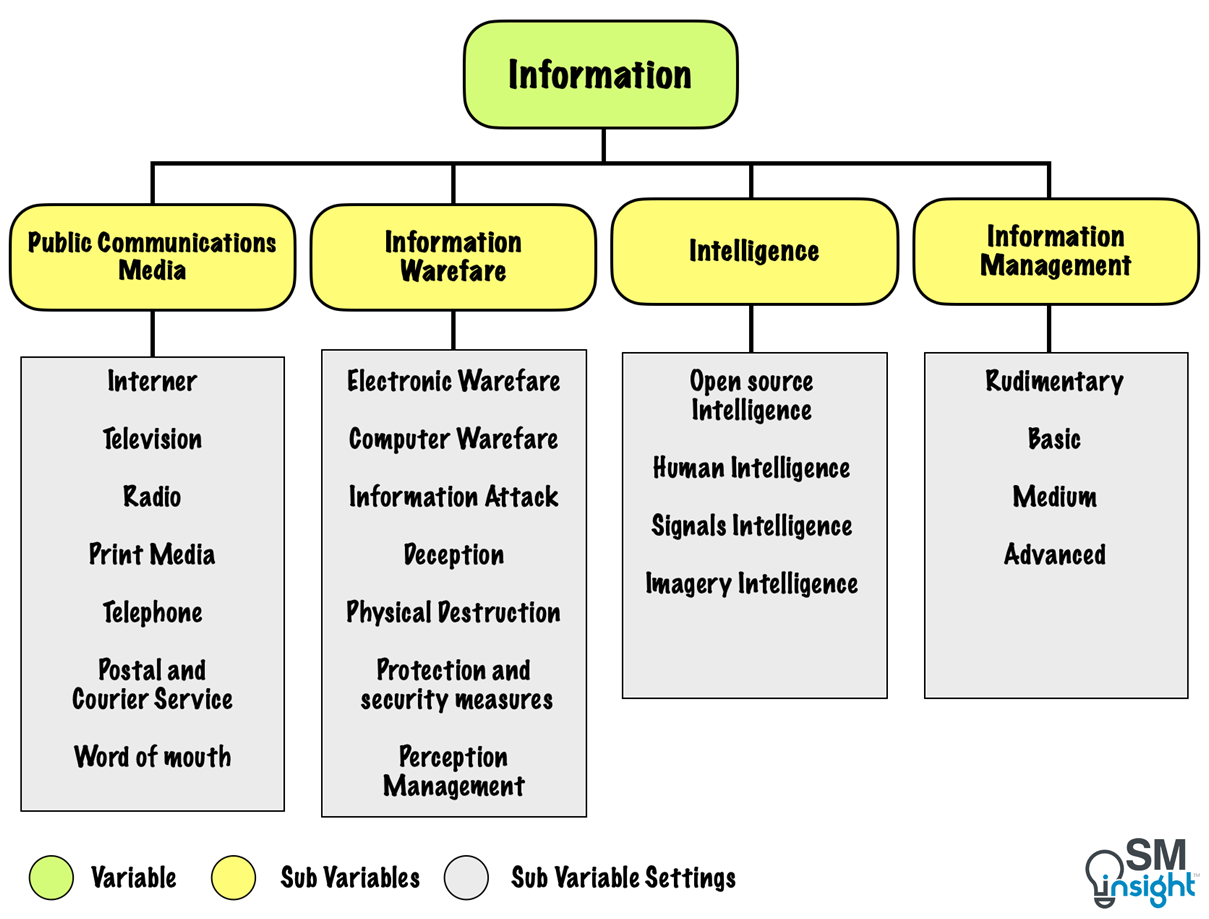
The definitions of each of the information sub-variable settings are as follows:
Public communications media
Describes the type of information or media sources that may be available to the public in an OE. This includes the internet, television, print media, telephone, postal and courier services as well as information spread through word of mouth.
Each of these media sources can have settings reflecting the level of availability as follows:
| None | Non-existent |
| Limited | Available in large cities only |
| Moderate | Available in cities and some towns |
| Widespread | Available down-to-town level |
The popularity and access to public communication media can vary from region to region. As businesses spend millions on marketing campaigns, it is crucial to analyze which platform provides the best reach and impact.
Information warfare
Relevant in a military context, these are specifically planned and integrated actions taken to achieve an information advantage at critical points and times.
Intelligence
Intelligence is the product of collecting, processing, integrating, evaluating, analyzing, and interpreting available information. In the military context, this concerns foreign nations, hostile or potentially hostile forces or elements, or areas of actual or potential operations.
A business must similarly build intelligence about its target market, customers, competitors, etc. There are four types of settings under the intelligence variable:
- Open-Source Intelligence: information is derived from the systematic collection, processing, and analysis of publicly available sources in response to intelligence requirements.
- Human intelligence: information is derived from human sources such as trained professionals that use a variety of methods, both passive and active, to collect information.
- Signals intelligence: intelligence produced by exploiting foreign communication systems and non-communications emitters (relevant purely in a military context).
- Imagery Intelligence: intelligence information is derived through the interpretation or analysis of imagery and collateral materials (relevant purely in a military context).
Information management
Describes the sophistication of procedures and information systems used to collect, process, store, display, disseminate, and protect information. It includes both people management and automatic processes that make relevant information available to the right person at the right time.
The level of information management can be classified into the following four settings:
- Rudimentary: Restricted to individuals or small groups supported by state-sponsored institutions (military or civilian) and non-state international groups. Commercial, business, and finance standalone systems are separate but basic. (Up to 24% encrypted)
- Basic: Integrated digital information management systems. Commercial, business, communications and finance systems are linked locally but not integrated. 25% to 50% encrypted (secure).
- Medium: Windows of information domination. Some commercial, business, communications and finance systems are integrated locally, while others are linked. Some are linked internationally. 51% to 75% encrypted (secure).
- Advanced: Uses state-of-the-art information systems to maintain information superiority. Commercial, business, communications, and finance systems are integrated locally and internationally. 76% to 90% encrypted (secure).
Infrastructure variable
The Infrastructure variable is composed of the basic facilities, services, and installations needed for the functioning of a community or society. The degradation or destruction of infrastructure will impact the entire OE, especially the Political, Military, Economic, Social, and Information variables.
When a business aims to expand into a new region, the sub-settings within the infrastructure variable act as critical checkpoints essential for ensuring seamless operations. This is particularly crucial for product-oriented businesses that rely on physical infrastructure to efficiently deliver products to their customers.
The specific sub-variables and their settings are as shown:
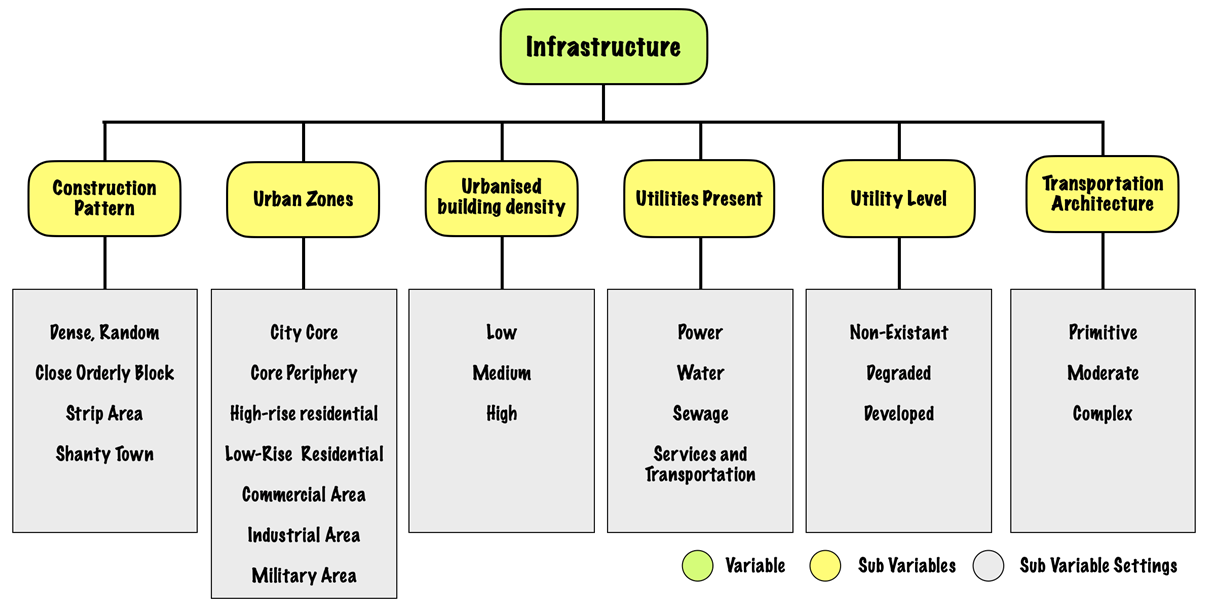
Construction pattern
This sub-variable maps the physical layout of buildings and streets in an urban area (village, town, or city) and consists of the following settings:
- Dense, Random Construction: Urban area consisting of closely packed buildings that often radiate irregularly from a single area, such as a religious building, dock area, or government center.
- Close orderly block: Urban area consisting of residential and commercial type buildings forming distinct rectangular blocks. Streets are generally wider and form rectangular patterns.
- Strip Area: a small urban area predominately built along a transportation route, such as a road or river. Usually assumes a long, thin, linear pattern.
- Shantytown: Random arrangement of poorly constructed structures made of any scrap material available, irregularly laid out, and connected by walking paths that may not accommodate vehicular traffic. These are areas composed of low-income or unemployed elements of the population.
Urban Zones
These are distinct areas or zones within a city that are geographically identifiable and are categorized by the predominant activity within their boundaries. Sub-variable settings under urban zones can be as follows:
- City Core: These are the heart of the urban area – the downtown or central business district. Relatively small and compact, such areas contain a large percentage of the urban area’s shops, offices, and public institutions.
- Core Periphery: These are areas located at the outer edges of the city core.
- High-rise residential areas: Typical of modern construction in larger cities and towns, these are areas consisting of multistoried apartments.
- Low-rise residential areas: Contain dispersed row houses or single-family dwellings with yards, gardens, trees, and fences. Street patterns are normally rectangular or curving. However, buildings are normally set back from the road.
- Commercial Area: These are areas with rows of stores, shops, and restaurants built along both sides of major streets that run through and between urban areas.
- Industrial Area: Industrial areas are generally located on or along major rail and highway routes in urban complexes. Older complexes may be located within dense, random construction or close orderly block areas.
- Military area: These are fortified areas controlled by defense.
Urbanized building density
These sub-variables classify a town based on the average building density and utilities present into the following settings:
- Low: Less than 15 buildings per town with no 2-story structures. Single economic industry structures are present in each town.
- Medium: 15 to 25 buildings per town with at least 3 multistory structures. One government center (5-building cluster) and site of significance (3-building cluster) per province. Two economic industry structures are present per town.
- High: Over 25 buildings per town with at least 5 multi-story structures clustered together or separated by a one-story building or open area. One government center (5-building cluster) and one site of significance (3-building cluster) per district. Three economic industry structures and constructions are present in the OE.
Utility and Utility level
Utilities include power, water, gas, sewage etc. Utility level describes its availability in a town in terms of approximate percentages. Each utility present has its respective service level and can be classified as follows:
- Non-Existent: under 25% present and operational
- Degraded: up to 50% present and operational
- Developed: over 75% present and operational
Transportation architecture
Describes the public road and transportation network, including airports, ports, rail, and surface road networks. Sub-variable settings under this can be classified as follows:
- Primitive: Single track or improved two-lane hard-surface road networks extending to all built-up areas. Single-line railway, no functioning airports, limited or no riverine transportation networks.
- Moderate: Improved multi-lane hard-surface road networks, extending to all built-up areas with secondary, two-lane hard-surface roads paralleling primary roads. Two to three 2-line railways, connecting at least 50% of the OE infrastructure. One functioning airport and, if present, moderate riverine transportation networks.
- Complex: Multi-lane hard-surface highway networks, extending to all built-up areas with secondary, multi-lane hard-surface roads paralleling primary roads. Three to four 2-line railways, connecting at least 75% of the OE infrastructure. Two to three large, functioning airports (jet-capable) and, if present, extensive riverine transportation networks.
Physical environment variable
This includes the geography and man-made structures as well as the climate and weather in the area of operation. These conditions may be real, notional, or a combination of both.
Sub-variable settings under the physical environment are as shown:
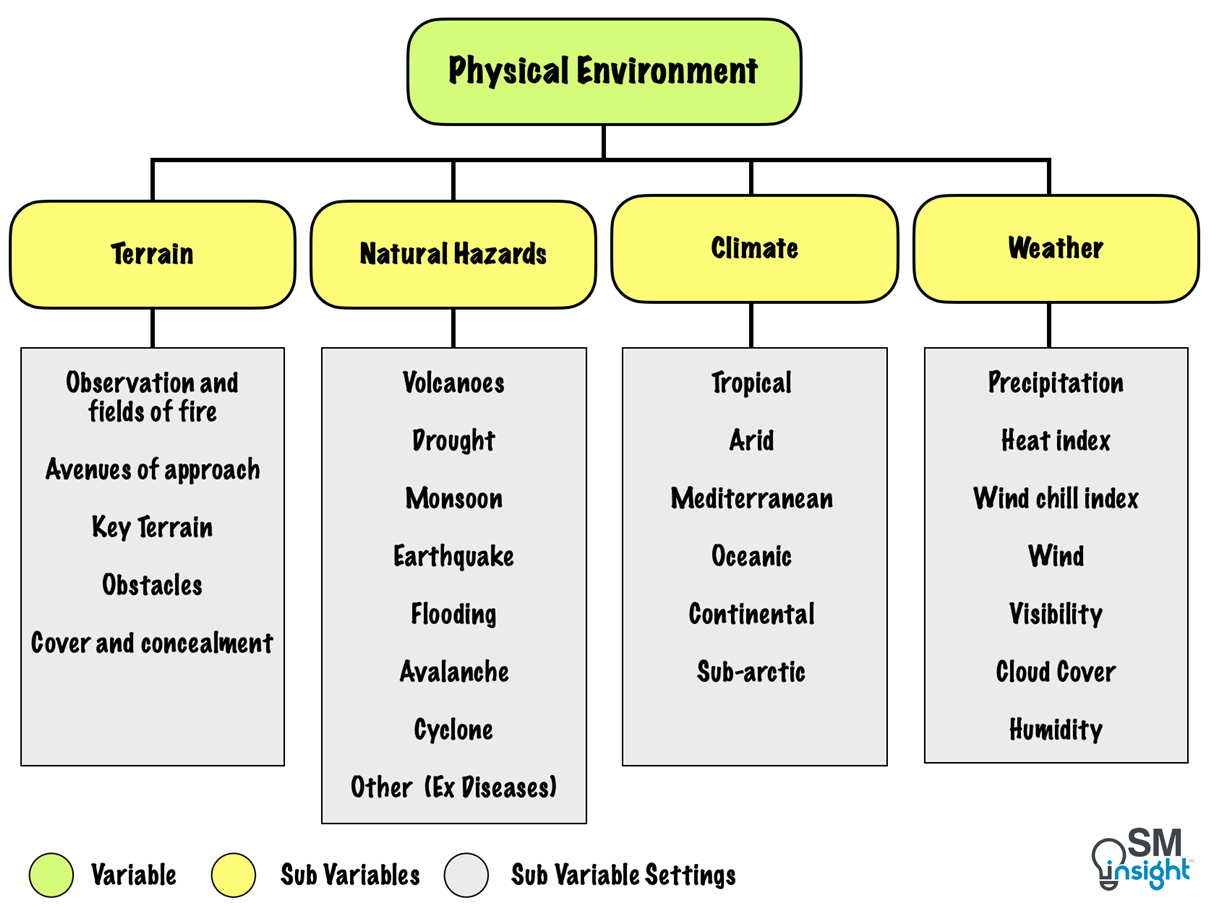
Most of the physical environment sub-variables are not relevant to the business context or are beyond a business’s control. Hence, they have not been discussed in more detail in this article.
Time variable
This variable describes the timing and duration of activities, events, or conditions that occur, exist or continue within an OE, as well as how the timing and duration are perceived by various actors in the OE.
Various aspects of time and its perception can affect and influence operations including how leaders employ manpower to achieve conditions of the desired end state. Different groups of people may perceive the concept of time in different ways.
Time sub-variables and their settings are as follows:
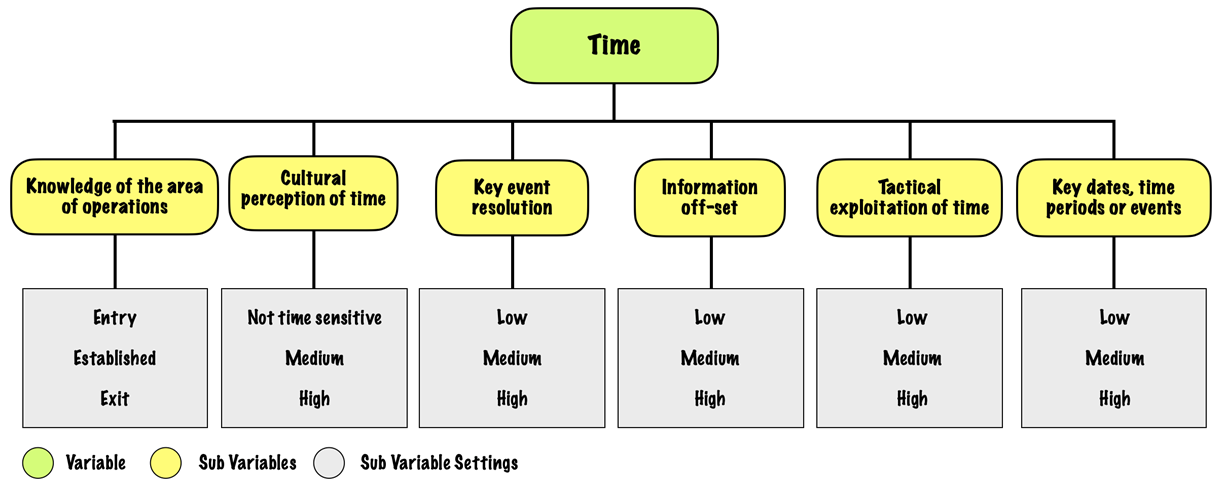
Knowledge of the area of operations
This is the amount of knowledge possessed based on the amount of time spent in the area of operation. The longer the time, the better the knowledge. It consists of three sub-variable settings:
- Entry: The unit is not established and has limited knowledge of the area of operations. In the business context, this refers to a situation where a firm is relatively new to the market and does not know its customers/competitors well.
- Established: The unit is established and has a moderate knowledge of its area of operations – in business, this means a firm has a more detailed understanding of its target market and customers/competitors.
- Exit: The unit is nearing the end of its deployment, is well-established and has detailed knowledge of the area of operations. In the business context, this relates to a high-level understanding of the market and customer/competitors – often demonstrated by mature and established businesses.
Cultural perception of time
This is about how a given culture in the area of operation perceives the concept of time. In the military context, this understanding is used as an operational planning factor and a tool to manipulate tactical and strategic advantages. In the business context, this can be used to understand how companies plan their strategy and react to the external environment.
There are three sub-variable settings under the cultural perception of time:
- Not Time Sensitive: The enemy views a protracted conflict as an advantage. They may see a long-term conflict as a key objective and are prepared for a long-term war.
In a business context, firms adopting a protracted mindset may prioritize sustainable growth and resilience over quick wins. They are in the market for the long term and are committed to weathering challenges with the ultimate goal of achieving sustained success. - Medium: View protracted conflict as a possible advantage but may change their view with time based on how the conflict/competition unfolds. In business, firms that fall under this category may eventually exit the market if their bets do not pay off.
- High: View protracted conflict as a liability and not to their advantage. Are open to timely resolution of conflict. In the business context, such firms target quick returns and may exit bets that do not pay in the short term.
Key-event resolution
This describes the level of clarity with which the events and their effects can be visualized in advance. Settings under this sub-variable may describe the entire scenario, including sub-events or may describe specific key events at a broad level.
Key-event resolution can be classified into the following levels:
- Low: Key-events effects depth is limited to 2nd-order effects – secondary or indirect consequences that result from key events.
- Medium: Key-event effects depth limited to 3rd-order effects – tertiary or third-level consequences that emerge as a result of the initial event and its immediate and secondary impacts.
- High: Key-event effects depth expands to capture 2nd, 3rd, and 4th order effects in response to actions and counter-actions.
Information off-set
This describes the level of information available which can positively influence an operation in a meaningful and predictive way. Having a high information offset means that there is a substantial amount of relevant and insightful data that can be used to enhance decision-making, anticipate outcomes, and contribute to the success of an operation.
Tactical exploitation of time
Describes the ability of the enemy to use time for tactical advantage. In the business context, a competitor may tactically exploit time by timing a product better in terms of technology or market readiness, letting the first-mover educate the customer and enter when there is a demand etc.
Based on the enemy’s (competitor’s) capability, this sub-variable can also be classified as low, medium and high – with low indicating limited capability and high indicating very high capability in exploiting time.
Key dates, time-periods, or events
These are routine, cyclical, planned, and unplanned key dates, periods, or events that significantly affect organizations and people.
Some of the examples include traditional wedding seasons, secular or religious holidays, anniversaries and historical incidents, elections, periods with a high likelihood of natural disasters, agricultural crop/livestock, market cycles etc.
Once key dates, periods, or events are determined, it is important to template such events and to analyze them for their impact on current or future operations.
Sources
1. “Challenging the Application of PMESII-PT in a Complex Environment”. MAJ Brian M. Ducote (United States Army), https://apps.dtic.mil/sti/pdfs/ADA523040.pdf. Accessed 27 Mar 2024.
2. “Analysis of Operational Data”. The U.S. Army Engineer Research and Development Center (ERDC), https://apps.dtic.mil/sti/tr/pdf/ADA624478.pdf. Accessed 27 Mar 2024.
3. “Comparison of the STEEPLE Strategy Methodology and the Department of Defense’s PMESII-PT Methodology”. J Walden, http://www.supplychainresearch.com/images/Walden_Strategy_Paper.pdf. Accessed 10 Mar 2024.
4. “SWOT Analysis – How to Do It Properly”. Strategic Management Insight, https://strategicmanagementinsight.com/tools/swot-analysis-how-to-do-it/. Accessed 27 Mar 2024.
5. “PEST & PESTEL Analysis”. Strategic Management Insight, https://strategicmanagementinsight.com/tools/pest-pestel-analysis/. Accessed 27 Mar 2024.
6. “QUEST—Quick Environmental Scanning Technique”. Professor Burt Nanus, https://www.sciencedirect.com/science/article/abs/pii/0024630182901182. Accessed 27 Mar 2024.
7. “Exercise Design (TC 7-101)”. DEPARTMENT OF THE ARMY, https://armypubs.army.mil/epubs/DR_pubs/DR_a/pdf/web/tc7_101.pdf. Accessed 27 Mar 2024.
8. “FROM CHIPS TO BEYOND: TAIWAN’S NEED FOR ECONOMIC DIVERSIFICATION”. Harvard Kennedy School – Growth Lab, https://growthlab.hks.harvard.edu/blog/chips-beyond-taiwan%E2%80%99s-need-economic-diversification. Accessed 09 Mar 2024.
9. “Workers making £88 Lululemon leggings claim they are beaten”. The Guardian, https://www.theguardian.com/global-development/2019/oct/14/workers-making-lululemon-leggings-claim-they-are-beaten. Accessed 28 Mar 2024.

